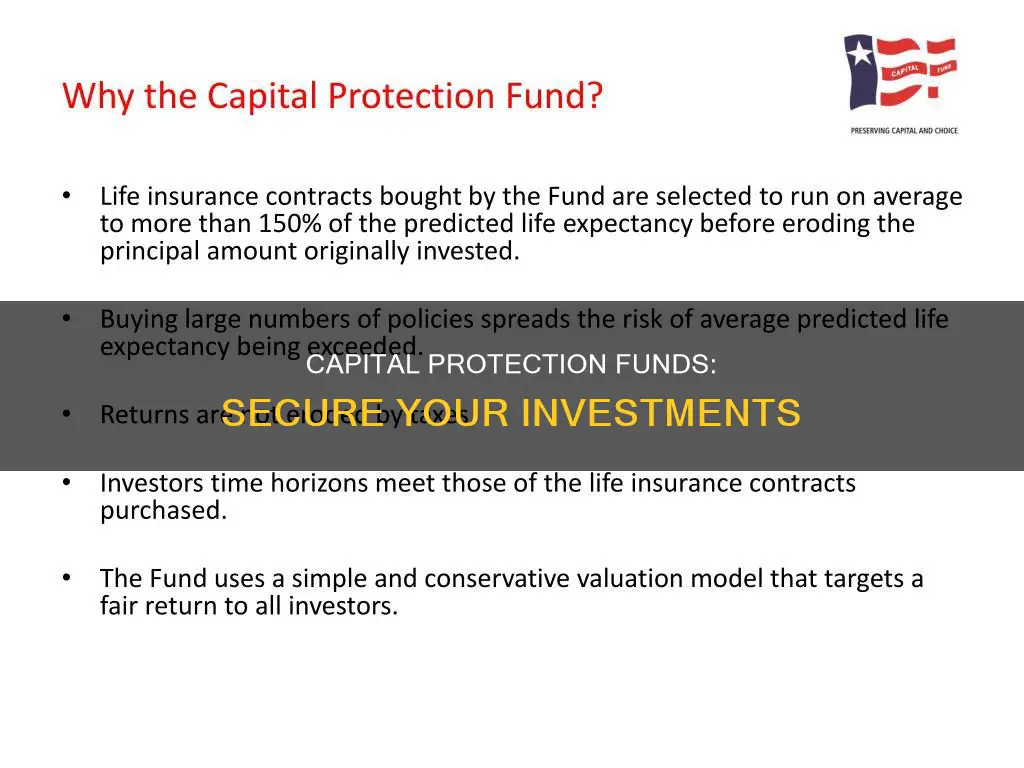
Capital protection funds are a type of investment vehicle that aims to balance capital preservation and the potential for growth. These funds are designed to protect an investor's capital during market downturns while also allowing them to benefit from potential gains during market upswings. The primary objective is to safeguard investors' interests and their capital during economic volatility, with a focus on debt instruments like AAA-rated bonds to minimise the risk of capital loss. These funds offer a conservative investment strategy, providing equity-like returns with fixed deposit-like protection. While they do not guarantee capital protection, they substantially reduce the risk of capital loss. With a mix of debt and equity investments, they are ideal for risk-averse investors seeking long-term investment options.
| Characteristics | Values |
|---|---|
| Investment type | Structured financial instrument |
| Investment goal | Equity-like returns with fixed deposit-like protection |
| Risk level | Conservative, low-risk |
| Investment focus | Debt, particularly AAA-rated bonds, with a small fraction in equity |
| Investment period | 1, 3 or 5 years |
| Returns | Not guaranteed, but expected to be between 3.02% and 14% |
| Taxation | Similar to debt funds; short-term or long-term capital gains tax applies |
| Suitability | Risk-averse investors, investors seeking stable returns, those with a low-risk appetite |
| Benefits | Capital protection, balanced portfolio, higher post-tax returns than fixed deposits |
| Considerations | Market risk, credit risk, interest rate risk, fund manager risk |
What You'll Learn
- Capital protection funds are ideal for risk-averse investors
- They provide equity-like returns with fixed deposit-like protection
- They are close-ended funds with a term of 1, 3 or 5 years
- Capital protection funds are not entirely risk-free
- They are suitable for investors who want to protect their capital and gain equity exposure

Capital protection funds are ideal for risk-averse investors
Capital Protection
One of the primary objectives of capital protection funds is to safeguard investors' capital during market downturns. These funds are designed to provide a level of security for investors' principal investment, typically by investing a significant portion of the fund (around 80%) in low-risk, fixed-income instruments such as AAA-rated bonds, treasury bills, and other highly-rated debt securities. This strategy helps to protect investors' funds during economic shocks and market volatility, as the value of debt instruments is less susceptible to market fluctuations.
Potential for Growth
While capital protection funds prioritize capital preservation, they also offer the potential for equity-like returns. A smaller portion of the fund (around 10-20%) is invested in equity and equity-related instruments. This allocation aims to generate higher returns compared to traditional fixed-income investments. By investing in capital protection funds, risk-averse investors can participate in the upside of the equity market while minimizing their exposure to market risk.
Balanced Portfolio
Capital protection funds offer investors a balanced portfolio that combines fixed-income securities and equity investments. This diversification allows investors to benefit from the stability of debt instruments while also gaining exposure to the growth potential of equities. This balanced approach helps to strike a balance between capital preservation and the pursuit of higher returns.
Suitable for Conservative Investors
Capital protection funds are well-suited for conservative investors with a low-risk appetite. These funds provide a level of security similar to fixed deposits, making them attractive to those who want to protect their principal amount. The funds' focus on capital preservation makes them a conservative investment option, particularly during market downturns, as they aim to mitigate downside risks and provide assurance in uncertain market conditions.
Long-Term Investment Horizon
Capital protection funds typically have lock-in periods of one, three, or five years. This long-term investment horizon aligns with the financial goals of risk-averse investors who are willing to commit their funds for a specified period. By investing in capital protection funds, investors can benefit from the compound growth that comes with long-term investing while enjoying the peace of mind that their principal investment is protected.
Investment Trust vs Fund: What's the Difference?
You may want to see also

They provide equity-like returns with fixed deposit-like protection
Capital protection funds are an attractive investment option for those seeking equity-like returns with the security of fixed deposits. These funds aim to safeguard investors' capital during market downturns while also allowing for capital appreciation when markets are performing well. Here's how they provide equity-like returns with fixed deposit-like protection:
Protecting Your Capital
Capital protection funds are designed to protect investors' principal investments, offering fixed deposit-like security. They achieve this by investing a significant portion of their portfolio in highly-rated fixed-income securities, such as AAA-rated bonds, which have a minimal chance of defaulting. This strategy ensures that investors can reclaim their initial investment, providing a level of protection akin to fixed deposits.
Generating Equity-Like Returns
While capital protection funds prioritise capital preservation, they also offer the potential for attractive returns. A small but significant fraction of the portfolio is invested in equities, allowing investors to benefit from the growth opportunities in the equity market. This combination of fixed-income securities and equity investments creates a balanced portfolio that can deliver equity-like returns while mitigating the risks associated with pure equity investments.
Close-Ended Structure
Capital protection funds are typically structured as close-ended funds, which means they can only be subscribed to during the initial offering period. This structure adds a layer of protection as it locks in investors' capital for a specified period, usually one, three, or five years. While this feature may reduce liquidity, it ensures that investors are committed to the fund for the long term, providing stability and minimising the impact of short-term market fluctuations.
Professional Management
Capital protection funds are managed by fund managers who employ strategic investment strategies to balance capital preservation and return generation. They carefully allocate the fund's assets between fixed-income securities and equity investments, taking into account market conditions and the fund's objectives. This professional management adds a layer of expertise, enhancing the potential for equity-like returns while maintaining the fund's focus on capital protection.
Suitability for Risk-Averse Investors
Capital protection funds are well-suited for risk-averse investors who seek the safety of fixed deposits but desire higher returns. These funds provide a level of security for the principal investment, reducing the potential downside risk. At the same time, the equity portion of the portfolio offers the opportunity for capital appreciation, allowing investors to benefit from market upturns. This combination makes capital protection funds an attractive option for those seeking a balance between capital preservation and return generation.
Fidelity Funds: Exploring AMD Investment Opportunities
You may want to see also

They are close-ended funds with a term of 1, 3 or 5 years
Capital protection funds are close-ended funds with a term of 1, 3 or 5 years. This means that they issue a fixed number of shares through an initial public offering (IPO) to raise capital for their initial investments. No new shares will be created, and no new money will flow into the fund. This is in contrast to open-ended funds, which accept a constant flow of new investment capital and issue new shares accordingly.
The closed-ended structure of capital protection funds means that they are well-suited to investing in illiquid securities. This is because there is no need to raise cash quickly to meet unexpected redemptions, so the capital is considered more stable. This relatively stable capital base allows fund managers to invest in securities that cannot easily be sold, such as emerging-markets stocks and municipal bonds.
The closed-ended structure also means that capital protection funds can make use of leverage—borrowed money—to boost their returns. This is because they do not have to maintain a large cash reserve to cover potential redemptions. As a result, closed-end funds may be able to offer higher overall returns than their open-fund counterparts.
The closed-ended nature of capital protection funds also gives rise to discounts and premiums. After the IPO, shares are traded on the open market, and the market itself determines the share price. This means that the share price may not match the net asset value of the fund's underlying holdings. If the share price is higher than the net asset value, the shares are said to be trading at a premium. If the share price is lower, the shares are said to be trading at a discount.
Debt Fund Investment: Choosing the Right Option
You may want to see also

Capital protection funds are not entirely risk-free
While capital protection funds aim to safeguard investors' capital during market downturns, it is important to note that they are not entirely risk-free. Here are some key points to consider:
Market Risk
Although a significant portion of a capital protection fund's portfolio is invested in debt instruments, there is still a component exposed to equity markets, which are subject to market risk and volatility. If the equity markets perform poorly, it can adversely affect the fund's overall returns. Therefore, investors in capital protection funds are not completely shielded from market risks.
Credit Risk
The debt instruments in which capital protection funds invest may carry a degree of credit risk. This refers to the risk of the issuer defaulting on their obligations, which could potentially impact the fund's performance. While these funds typically invest in high-quality, highly-rated debt instruments, there is always a chance of default, no matter how small.
Interest Rate Risk
Changes in interest rates can affect the value of the debt instruments held by capital protection funds. If interest rates rise, for example, the value of existing bonds may fall, leading to potential losses in the fund's value. Conversely, if interest rates fall, the fund may benefit from higher bond prices.
Fund Manager Risk
The performance of capital protection funds relies heavily on the investment decisions and strategies employed by the fund manager. Poor investment choices, ineffective risk management, or strategic errors can negatively impact the fund's returns. As such, the success of these funds is closely tied to the competence and skill of the fund manager.
Liquidity Risk
Capital protection funds are typically close-ended funds, which means they are not highly liquid. Investors may find it challenging to exit their investments before the specified maturity date, as these funds often have lock-in periods. Therefore, capital protection funds are more suitable for investors with a long-term investment horizon who can commit their funds for the specified period.
In conclusion, while capital protection funds offer a degree of security and are designed to mitigate downside risks, they do carry certain risks. Investors should carefully evaluate these risks, the fund's objectives, and their own investment goals and risk tolerance before making any investment decisions.
Malaysia's Best Mutual Funds: Where to Invest?
You may want to see also

They are suitable for investors who want to protect their capital and gain equity exposure
Capital protection funds are ideal for investors who want to protect their capital and gain equity exposure. These funds are designed to balance capital preservation and the potential for growth. While they primarily invest in secure debt instruments, they also allocate a portion of the portfolio to equity investments, allowing investors to benefit from potential gains in the equity market.
The typical capital protection fund invests around 80% of its assets in highly-rated fixed-income securities, such as AAA-rated bonds, and the remaining 20% in equity. This allocation provides a safety net for the initial investment while also offering the opportunity for higher returns. For example, if an investor puts ₹1,000 into a capital protection fund, the fund manager might allocate ₹900 into a debt instrument yielding 10% interest at maturity, guaranteeing the recovery of the principal investment. The remaining ₹100 is then invested in equity instruments, aiming for higher returns.
These funds are suitable for investors who want to participate in the equity market while minimising risk. They are often recommended for risk-averse investors, including those who are new to investing or those who have a low-risk appetite. By investing in capital protection funds, these individuals can gain exposure to the equity market while safeguarding their principal amount.
Additionally, capital protection funds can be a good choice for investors who want to avoid interest rate volatility associated with traditional fixed-income investments. The debt component of these funds provides stability, as they primarily invest in fixed-income instruments with low interest rate risk.
It is important to note that capital protection funds are not entirely risk-free. While they offer a degree of protection for the initial investment, the equity portion is still subject to market risk and volatility. Therefore, investors should carefully consider their financial goals, risk tolerance, and investment horizon before deciding to invest in capital protection funds.
Mutual Funds vs ULIPs: Where Should You Invest Your Money?
You may want to see also
Frequently asked questions
A Capital Protection Fund is a type of closed-end hybrid fund that aims to safeguard an investor's capital during market downturns while also offering the potential for capital appreciation during market upswings.
Capital Protection Funds invest in a mix of fixed-income instruments, such as bonds and debt securities, and equity instruments. Typically, around 80% of the fund is invested in secure debt instruments, with the remaining 20% invested in equities to boost returns.
Capital Protection Funds offer a balanced portfolio that combines the stability of fixed-income securities with the potential gains of equity investments. They are ideal for risk-averse investors who want to protect their capital while also seeking potential growth.
Capital Protection Funds typically offer better post-tax returns than Fixed Deposits (FDs) and other fixed-income options. They provide a level of security similar to FDs while also offering the potential for higher returns.
Capital Protection Funds are suitable for investors who are risk-averse, seeking stable returns, and have a low-risk appetite. They are also ideal for novice or first-time investors looking for equity exposure without taking on high risk.







